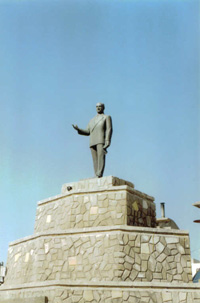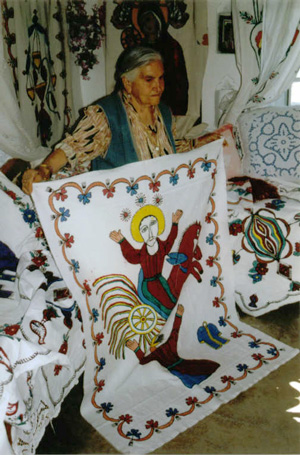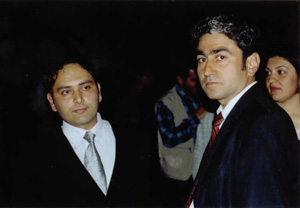
Demet Varli joined our group; she would show us around in Tur Abdin (= the mountains of the slaves of God) and be our interpreter for the coming three days.

Lecture by Demet Varli; viewing DVDs on her laptop
She has a very nice and strange background. She is graduated as a art historian at the İstanbul University and was interested in the art history of the Suryoye. As being a Turkish Muslim it is impossible for her to learn Suryoye (the language) in Turkey which she would like to extend to the study on the Suryoye. One of the few places where you can study Aramaic is the University of Leiden. So she learned Dutch, to be able to study in Leiden and study the language and culture of the Suryoye. She hopes to continue in September but due of visa problems she is not sure. Because she is a Turkish Muslim the Turkish government does not allow her to stay overnight in the monastery.
Through the monastery we could rent a minibus driven by Said, who as later turned out knows everybody in Tur Abdin and was very kind and useful during our stay in Tur Abdin.
 Statue of Mustafa Kemal Atatürk in Mardin
Statue of Mustafa Kemal Atatürk in MardinFirst of course we went to Mardin, see the city, learn something more about the Suryoye. Mardin has a rich history and was a cross road between many cultures (Arabic-Suryoye-Kurdish) and religions (Christian and Muslim).
The Suryoye population almost disappeared in the Tur Abdin region and is living abroad.
Did we went to Tur Abdin to meet the Suryoye or to visit the history of the Suryoye?
The old city of Mardin was again totally different from Diyarbakır and İstanbul. The city was build against a hill and there was one main road, with beside that road a lot of small go troughs: a bazaar. The architecture has a strong Arabic influence and nice stone carving which was in the past one of the special skills of the Suryoye and now taken over by the other ethnic group.
Besides the old town is a kilometre downhill the New Mardin constructed. Demet is staying with friends in New Mardin.
At 11.00 we had to be back because Erkan Özgen, Diyarbakırian artist, would come to the monastery to talk about his work and that of other artist from Diyarbakır. He came late because of some health problems of his girlfriend Janna, who came with him; and although Janna, was not an artist, we needed her badly, because of her good English. Some of the students did not wait for Erkan but left to explore the surroundings of the monastery.

Erkan Özgen (middle), his girlfriend Janna (left) and Alite Thijsen
Sitting in the patio of the monastery, drinking tea, talking with Erkan, Janna and Demet. Erkan showed some interesting works of himself and his friends which all reflected in one way or another the political context of the region. The people of the monastery also showed interest in the videos but we were not sure if they were pleased with the presentation of videos reflecting the reality of the area from a Kurdish point of view. Sometimes it was quite difficult to know the sensibility of a topic or a question.
Erkan talked also about the position of a artist in Turkey, the influence and importance of the curators etc. It was a very informative and interesting meeting.

Nasra
Later in the afternoon we all went to Mardin for a walk, drink, buying some food for breakfast. Some went to visit Nasra. Nasra is the person who silkscreen printed (by hand) all the printed clothes we saw in all the Suryoye churches all over Tur Abdin.
At about 19.00 we all met at the opening of the exhibition of Nurullah Gorhan and artist from Mardin who just finished an artist residency in Platform Garanti.

Nurullah Gorhan (left)
His work was based on wood carvings and in İstanbul he start to make videos. Most of us liked the video where he tries to capture a second of İstanbul between his finger tips. He was glad with the video were a Coca Cola bottle was a symbol of the female oppression when it was shot in pieces. The meeting started with a discourse and all the paintings where covered with white blankets. Nurullah Gorhan was nominated with a prize by the cultural foundation of Mardin. It was a pity that we could not stay longer: we had to be back at the monastery at 21.00 o’clock.
The group that explored the surroundings of the monastery discovered houses and chapels inside the caves. No wolves or junkies as brother Johannes told them.